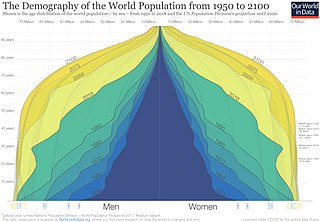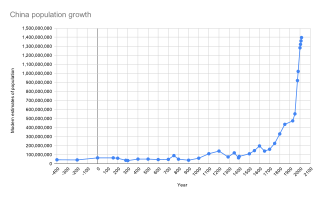
Population typically refers to the number of people in a single area, whether it be a city or town, region, country, continent, or the world. Governments typically quantify the size of the resident population within their jurisdiction using a census, a process of collecting, analysing, compiling, and publishing data regarding a population.

The demographics of China demonstrate a huge population with a relatively small youth component, partially a result of China's one-child policy. China's population reached 1 billion in late 1981.

The term one-child policy refers to a population planning initiative in China implemented between 1980 and 2015 to curb the country's population growth by restricting many families to a single child. That initiative was part of a much broader effort to control population growth that began in 1970 and ended in 2021, a half century program that included minimum ages at marriage and childbearing, two-child limits for many couples, minimum time intervals between births, heavy surveillance, and stiff fines for non-compliance. The program had wide-ranging social, cultural, economic, and demographic effects, although the contribution of one-child restrictions to the broader program has been the subject of controversy.

Demography is the statistical study of populations, especially human beings.

Human population planning is the practice of intentionally controlling the growth rate of a human population. The practice, traditionally referred to as population control, had historically been implemented mainly with the goal of increasing population growth, though from the 1950s to the 1980s, concerns about overpopulation and its effects on poverty, the environment and political stability led to efforts to reduce population growth rates in many countries. More recently, however, several countries such as China, Japan, South Korea, Russia, Iran, Italy, Spain, Finland, Hungary and Estonia have begun efforts to boost birth rates once again, generally as a response to looming demographic crises.

In demography, demographic transition is a phenomenon and theory which refers to the historical shift from high birth rates and high death rates in societies with minimal technology, education and economic development, to low birth rates and low death rates in societies with advanced technology, education and economic development, as well as the stages between these two scenarios. Although this shift has occurred in many industrialized countries, the theory and model are frequently imprecise when applied to individual countries due to specific social, political and economic factors affecting particular populations.

Family planning is the consideration of the number of children a person wishes to have, including the choice to have no children, and the age at which they wish to have them. Things that may play a role on family planning decisions include marital situation, career or work considerations, financial situations. If sexually active, family planning may involve the use of contraception and other techniques to control the timing of reproduction.

The birth rate for a given period is the total number of live human births per 1,000 population divided by the length of the period in years. The number of live births is normally taken from a universal registration system for births; population counts from a census, and estimation through specialized demographic techniques. The birth rate is used to calculate population growth. The estimated average population may be taken as the mid-year population.
Zero population growth, sometimes abbreviated ZPG, is a condition of demographic balance where the number of people in a specified population neither grows nor declines, that is, the number of births plus in-migrants equals the number of deaths plus out-migrants. ZPG has been a prominent political movement since the 1960’s. As part of the concept of optimum population, the movement considers zero population growth to be an objective towards which countries and the whole world should strive in the interests of accomplishing long-term optimal standards and conditions of living.

The total fertility rate (TFR) of a population is the average number of children that would be born to a woman over her lifetime if:
- she were to experience the exact current age-specific fertility rates (ASFRs) through her lifetime
- she were to live from birth until the end of her reproductive life.

Sub-replacement fertility is a total fertility rate (TFR) that leads to each new generation being less populous than the older, previous one in a given area. The United Nations Population Division defines sub-replacement fertility as any rate below approximately 2.1 children born per woman of childbearing age, but the threshold can be as high as 3.4 in some developing countries because of higher mortality rates. Taken globally, the total fertility rate at replacement was 2.33 children per woman in 2003. This can be "translated" as 2 children per woman to replace the parents, plus a "third of a child" to make up for the higher probability of males born and mortality prior to the end of a person's fertile life. In 2020, the average global fertility rate was around 2.4 children born per woman.

A population pyramid or "age-sex pyramid" is a graphical illustration of the distribution of a population by age groups and sex; it typically takes the shape of a pyramid when the population is growing. Males are usually shown on the left and females on the right, and they may be measured in absolute numbers or as a percentage of the total population. The pyramid can be used to visualize the age of a particular population. It is also used in ecology to determine the overall age distribution of a population; an indication of the reproductive capabilities and likelihood of the continuation of a species. Number of people per unit area of land is called population density.
Population momentum is a consequence of the demographic transition. Population momentum explains why a population will continue to grow even if the fertility rate declines. Population momentum occurs because it is not only the number of children per woman that determine population growth, but also the number of women in reproductive age. Eventually, when the fertility rate reaches the replacement rate and the population size of women in the reproductive age bracket stabilizes, the population achieves equilibrium and population momentum comes to an end. Population momentum is defined as the ratio of the size of the population at that new equilibrium level to the size of the initial population. Population momentum usually occurs in populations that are growing.
Demographic dividend, as defined by the United Nations Population Fund (UNFPA), is "the economic growth potential that can result from shifts in a population’s age structure, mainly when the share of the working-age population is larger than the non-working-age share of the population ". In other words, it is “a boost in economic productivity that occurs when there are growing numbers of people in the workforce relative to the number of dependents”. UNFPA stated that “A country with both increasing numbers of young people and declining fertility has the potential to reap a demographic dividend."
A two-child policy is a government-imposed limit of two children allowed per family or the payment of government subsidies only to the first two children.
Missing women of China is a widely known phenomenon referring to the unusual shortfall of female population resulting from cultural influences and government policy. The term "missing women" was coined by economist Amartya Sen, winner of the 1998 Nobel Memorial Prize in Economic Sciences, to describe a distorted population sex ratio in which the number of males far outweighed the number of females. Female disadvantages in child survival throughout China reflects a long pattern of sex-based discrimination. Preferences for sons are common in China owing to their ability to carry on family names, their wealth inheritance, and the idea that they are typically the ones to care for their parents once they are older. Limiting the ability for parents to have numerous children forces them to think of logical and long term reasons to have a male or female child. Chinese parents are known to favor large families, and to prefer sons over daughters in efforts to create more directed family resources. The result of the discrimination and male preference is a shortfall of women and an extremely unbalanced sex ratio in the population of China. China's sex-ratio is comparatively the most skewed of any country in the global sphere.
Song Jian is a Chinese aerospace engineer, demographer, and politician. He was deputy chief designer of China's submarine-launched ballistic missile (JL-1) and one of the country's leading scientists in the post-Cultural Revolution era. After a decade of two-child restrictions in the 1970s, and following the Chinese government's announcement in 1979 to advocate for one child per family, he became a leading advocate for rapid implementation and broad coverage of China's one-child policy. He served in high-ranking political positions including Vice Minister of Aerospace Industry, Director of the State Science and Technology Commission (1985–1998), vice-premier-level State Councillor (1986–1998), President of the Chinese Academy of Engineering, and Vice Chairperson of the Chinese People's Political Consultative Conference.

China's population is aging faster than almost all other countries in modern history. In 2050, the proportion of Chinese over retirement age will become 39 percent of the total population. China is rapidly aging at an earlier stage of its development than other countries. Current demographic trends could hinder economic growth and create challenging social problems in China.

In South Korea, aging refers to an increase in the proportion of senior citizens to the total population. The term "senior citizens" include those aged 65 or older. According to Article 3 no.1 of the Framework Act on Low Birthrate of an Aging Society, the term "aging population" refers to the increasing proportion of elderly people in the entire population.

The population history of China covers the long-term pattern of population growth in China and its impact on the history of China. The population went through many cycles that generally reached peaks along each imperial power and was decimated due to wars and barbarian invasions. The census data shows that the population as percentage share of the world has a long-term average of 26%, with 6% standard deviation. The minimum could be as low as 16% while the maximum as high as 33%. In the late 20th century and the early 21st century, the percentage share has been trending down. This was caused by two opposite factors: On one hand, the world population has been growing explosively. On the other hand, in order to address the poverty issue, China implemented a strict birth control policy. For recent trends see demographics of China and China.











